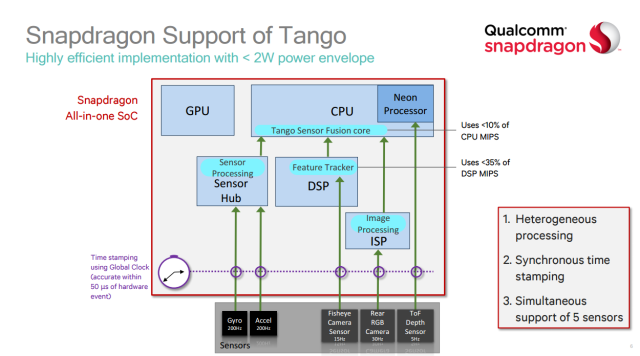
Google's Project Tango, an augmented reality project that packs a smartphone with 3D vision sensors, is finally on its way to consumers in the form of the Lenovo Phab 2 Pro. When the Phab 2 Pro was unveiled, the internals were a bit of a surprise. Previously, a lot was made of the Movidius computer vision chip inside the Project Tango prototype, but when the consumer version was announced, there was no extra vision processing chip to be found. All of Tango's augmented reality processing runs on the Qualcomm Snapdragon 652 SoC.
Qualcomm calls this the "Snapdragon Heterogeneous Processing Architecture," which in English means typically non-compute-heavy chips in an SoC—the DSP, sensor hub, and Image Signal Processor (ISP)—all get recruited for compute duties in a Tango phone. The DSP, or digital signal processor, usually handles the multimedia duties of a phone, but Qualcomm has been expanding the Snapdragon DSP (called the "Hexagon DSP") for general-purpose computing for some time. As a result, Qualcomm claims you'll be able to run all of Tango's algorithms and sensors with a "less than 10%" CPU overhead compared to a normal app. Qualcomm also touts all of this as being low-power, but that's something we'll have to investigate when we get ahold of final hardware.Qualcomm revealed it has been "working closely" with the Google Tango team for the last year and a half to get Tango up and running on Snapdragon. With no extra co-processors to add, the difference between a Tango and non-Tango phone is just the extra depth sensor and motion tracking camera. Qualcomm hopes this reduction in components will lead to Tango technology becoming commonplace in smartphones. "We are committed to Tango and we believe in this technology." Seshu Madhavapeddy, VP of product management for Qualcomm, told Ars. "We see broad adoption of this technology as forthcoming and we would like to support that."
The Phab 2 Pro only shipping with the Snapdragon 652 is a bit of a disappointment for general-purpose smartphone computing, but there's a good chance we'll see a higher-end Tango phone eventually. Qualcomm is announcing Tango support on the Snapdragon 820 in addition to the 652, and future 800 and 600 series chips will also support Tango.
We'll get a chance to take a hard look at Tango with the Lenovo Phab 2 Pro, which is launching in September for $499 (~£400).
Listing image by Qualcomm
reader comments
17